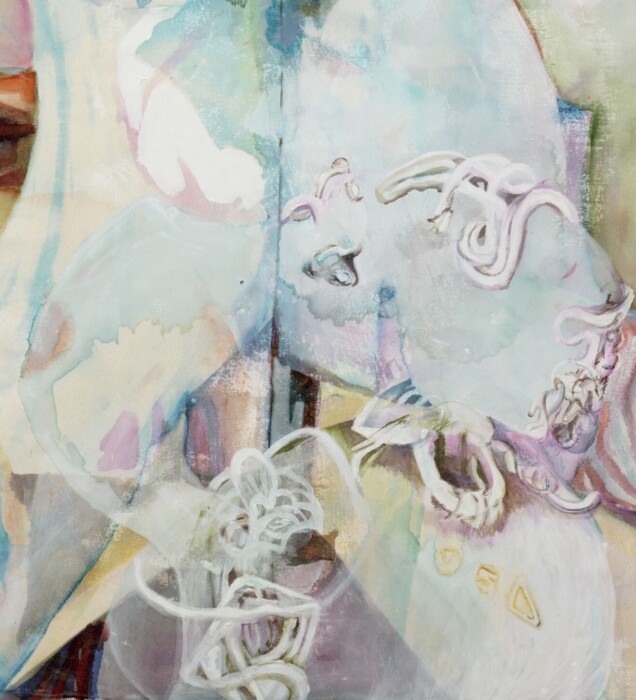Notes on spilt milk
Clara Palmberger-Suesse
i. (looking)
I misread an ad passing by a train station, ‘split milk’ instead of ‘spilt milk’ as part of a saying that morally supports the acceptance of the mishaps in life.
What I had perceived was nothing but the inversion of two similar letters, a glitch that seemed funny as it corresponded with its original signification. ‘Spilt milk’ was represented in a figure composed of a gush, splotches and a puddle, white against a blue background. It is a representation of the substance taking over, matter withdrawing from our control over it like ‘the being-in-itself’ in Sartre, as an uncontrollable matter which ‘lacks self- consciousness and is massive, full and actual’ as opposed to the being-for-itself that is the being of consciousness that represents freedom.[1] The letters had flipped so the new meaning was brought about by the slipperiness of looking, by eyes moving in ways that are not linear.
ii. (movement)
Milk in advertisement has found its own image, attending to the visual appeal of spillings, of drips and splashes that harbours within it an indefinite potential of forms, thus the visual appeal of the liquid is that it evokes its movement, that is of a specific quality and speed, making visible a force. The event of milk hitting a surface, producing a splotch. The sudden arrest from liquid to form attracts attention as it posits an end, seizing its drama.
‘87. Painting is the language of form and space that reminds me that I am made of the same stuff as the world’.[2]
I relate to the formless in its states of being spilled and thrown, in intensities that I lose and find myself in.
iii. (material identity)
Milk is overdetermined by capitalism
It’s visual homogeneity and opacity make milk prone to deception. At the advent of industrial food production, milk was adulterated with all kinds of white powders and emulsions to the point of toxicity.[3]
Milk became a substance of projection and speculation that played an important role in the invention of economic psychology.
Ernst Dichter, a student of Freud, pioneered the field of economic psychology through his research on Austrian and American milk-drinking habits in 1936 which he later marketed to American companies, branding himself as a ‘Viennese psychoanalyst’ capable of applying psychological insights to marketing strategies. ‘In an economy of abundance and desire […] consumer motivation is largely subliminal: the id goes shopping – or, at least, it needed to be persuaded to go shopping’ (Bennett, 2016). Dichter then leveraged his perceived authority with pseudo-scientific arguments for sale, such as the claim that nudity dilates the pupils, thus making viewers more susceptible to advertising. With this, psychoanalysis, with all its notions, assumptions, and myths, played a foundational role in shaping consumerism. Through the story of Dichter, we catch a glimpse of the possibility that consumerist needs and desires may originate entirely from fiction that created its own signifying order.
Their marketing as essential children’s nourishment, in turn, leads to its association with evil in film.[4] Depending on this connotation, the uncanny is evoked, following the stylistic device of juxtaposition. The act of evil is either announced or concluded by drinking a glass of milk.
The origins of this trope can be traced back to the 50s. In Roland Barthes words, milk ‘as a token of strength’ is ‘calm, white, lucid, the equal of reality’ consumed by the hero before ‘drawing his avenging Colt’ (Barthes, 1957).
iv. (material unconscious)
Milk is also presumably one of the first mediums of paint.[5] But that is not more than an interesting information, as there is no origin of milk. Rather, milk is ambivalent in itself, both benign and evil, intimate and alienated, mythological and poetic, ambivalent, multivalent. milk-paint, paint-milk. Our relation to milk is economic. But economy is more than capitalist.
Splotches are an organisation of substance, that is an organisation of enjoyment. The splotch is a surplus, on the painting surface a splotch produces an excessive visuality, as it is double, both a ‘substance jumping out’ or creeping below the threshold of the surface thus exceeding signification and a figure that folds into ‘the endless flow of figuration’.[6]
v. (split milk)
The advertisement imagery of milk gushes and splashes is virtual, in the sense of illustrating a ‘movement of actualization’. As Deleuze points out, ‘the virtual’ is a key concept of memory and life in Henri Bergson’s philosophy. Memory is ‘a virtual co-existence’, the past is thus ‘the being-in-itself’ which is always there. It is also what separates the image from matter. Unlike the image, Bergson states that, ‘matter has no interior, no underneath, (…) possesses neither power of any kind, is spread out as mere surface’ (1896). 118 years later, however, the surface is the place ‘where time becomes material space’ (Bruno, 2014).
In painting, the surface is more than the place of its materiality, it is the image itself, the imaginary is immanent to the material. In milk imagery, the repetitive templates of splotches, splashes, gushes are placeholders, a concept of the image as mere image. ‘Mere’ however is perhaps not a degradation- not because of its capability to reduce something to its pure essence, like the sublime surface of modern painting but rather as a smallness that is relatable. Mere milk. Mere painting. A negativity yielding new potential.
Footnotes
1. In Jean-Paul Sartre, this uncontrollable matter would correspond to the being-in-itself which ‘lacks self- consciousness and is massive, full and actual’ as opposed to the being-for-itself that is the being of consciousness that represents freedom.
2. Molly Zuckerman-Hartung, 95 Theses of Painting: http://www.mollyzuckermanhartung.com/index.php?q=Page&ID=3
3. As can be read in the report, Observations on London Milk, (estimated 1850) milk was not only most commonly mixed with ‘water, flour, starch’ (p.30). ‘Indeed so peculiar is the London milk that you can tell it by its smell.’ Raw sheep brains, those ‘rendered unsaleable’ were squished by hands and mixed with water. ‘treacle, salt, whiting’ and toxic ‘sugar of lead’.
4. Famous examples include Clockwork Orange, No Country for Old Men, Inglorious Basterds and Get Out.
5. In the Sibudu Cave, South Africa, a 49,000 year old paint mixture of ochre and milk has been discovered: https://www.archaeology.org/news/3448-south-africa-paleolithic-milk-based-paint
6. This is inspired by Timothy Morton’s application of the literary figures of Ekphrasis and Fantasia to the appeal of spices for the development of capitalism.
References
Amiri, R (2007) Being-for-itself in Sartre’s Philosophy: A Critical Examination (2008) Journal of Philosophical Theological Research, 8, pp.33-57
Barthes, R. (1957), Mythologies, Translated by Cape, J., New York: Noonday Press, pp.51-62
Bennett, D. (2016), The Currency of Desire: Libidinal Economy, Psychoanalysis and Sexual Revolution, London: Lawrence & Wishart, p.103
Bergson, H. (1896), Memory and Matter, pp.148-149. Quoted in: Deleuze, G., (1991), Bergsonism, translated by Tomlinson, H. and Habberjam, B., New York: Zone Books, p.43
Bruno, G. (2014), Surface: Matters of aesthetics, materiality, and media, Chicago: University of Chicago Press
Morton, T. (2000), The Poetics of Spice: Romantic Consumerism and the Exotic, Cambridge: Cambridge Studies Romanticism Cambridge University Press
Rugg, H. H., (c1850) Observations on London milk: showing its unhealthy character, and poisonous adulterations: with remarks on the food of the cows, their pestilential places of confinement, with suggestions for remedying the evil: https://wellcomecollection.org/works/tybeajy5/items?canvas=36

Notes on spilt milk
Notes on spilt milk

Conversation: where critical friends of itinerant space are invited to comment on journal submissions as part of an ongoing research dialogue.